Hydrangea Bretschneider - important information about the honeycomb
Nowadays you will hardly surprise anyone with hydrangea in the garden. Paniculate and tree-like, white and colored - for every taste. Unpretentious, hardy, "patient" - these flowers have rightfully earned the attention and love of flower growers. But there is a variety, the fame and fame of which lies ahead. This is Bretschneider's hydrangea.
- History of origin
- Characteristics of the variety
- External description
- Popular varieties
- Landing features
- Timing
- Site selection and preparation
- Preparation of planting material
- Landing technology
- How to care
- Watering
- Top dressing
- Pruning
- Preparing for winter
- Reproduction
- Diseases and pests: treatment and prevention
- Application in landscape design
- Testimonials
- Useful videos
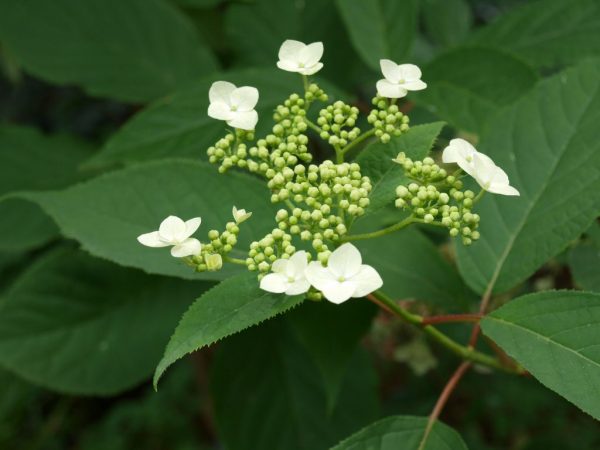
Hydrangea bretschneider
Information for the article about this type of ornamental shrub is taken from publications of Western European nurseries: Mustila arboretums (Central Finland) and Hiller (Great Britain), Appelterna Gardens (Netherlands). And also from the site of the Botanical Garden-Institute of the Far Eastern Branch of the Russian Academy of Sciences. They not only sell seedlings, but also carry out extensive breeding work to improve the properties of this still neglected hydrangea. And that means - everyone knows about her!
History of origin
Bretschneideri has been known as a species since 1883. His homeland is the mountainous regions of China. It is no coincidence that another name for the flower is the Himalayan hydrangea.
We owe the appearance of this plant in the gardens of Europe to the Russian doctor and scientist Emil Vasilyevich Bretschneider, who lived and worked in Beijing for a long time. He penned the well-known among biologists book "History of European botanical discoveries in China".
It was introduced to Europe in 1920 and was originally grown as a greenhouse plant. The development of frost-resistant varieties made this shrub a garden one.
On the territory of Russia, Bretschneider's hydrangea is the most winter-hardy. Despite this, it is grown mainly in botanical gardens and collectors. Although the management of the Main Botanical Garden (GBS) of the Russian Academy of Sciences, back in 1978, Bertschneider's hydrangea was proposed as the main crop for landscaping the park zone of Moscow - this shrub is so beautiful and hardy.
Characteristics of the variety
This ornamental plant has many names: Hydrangea heteromalla Bretschneideri, variegated, shaggy, woolly. And they all reflect its external signs.
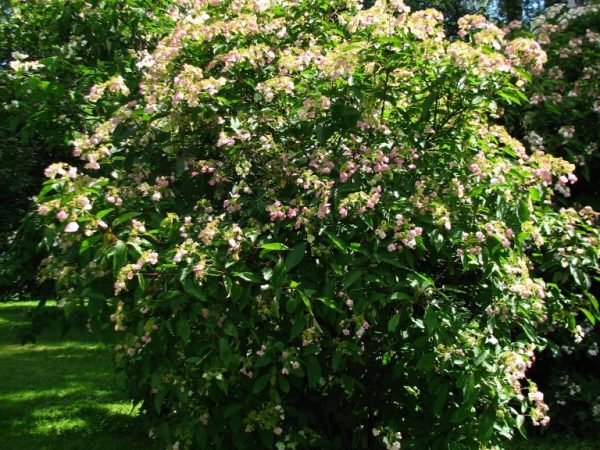
Hydrangea bretschneider ornamental trees and shrubs
The species is referred to as ground cover, because in the wild, it grows in the undergrowth and covers the ground with its dense foliage. It differs in:
- unpretentiousness in growing and care;
- cold resistance;
- high drought resistance;
- long flowering;
- variety of forms.
The culture begins to bloom at the 6th year. Blooms before all garden hydrangeas - already in mid-June. Flowering continues until the end of August.
External description
It is a sturdy, dense, deciduous shrub with reddish-brown bark, the scales of which, flaking off, form a beautiful pattern.
Young shoots, like the undersides of leaves, are covered with short soft hairs. The stems quickly woody, become strong, stiff. The plant grows from mid-April to late September. The growth rate is average.
The leaves are ovoid, narrow, up to 12 cm in length, have a different shade: from above - a rich green color, from below - first white, then greenish with a delicate downy. Attached to the trunk with a red-brown stalk. They bloom late - at the end of May. In the sun, they can acquire a crimson color, turning into brown-yellow by autumn.
Inflorescences are a flat shield of 400-500 fertile (fertile) small flowers, surrounded by 40-50 large sterile flowers with a diameter of 2.5 cm around the perimeter.Lace caps up to 15 cm in diameter are very decorative at any time: at the beginning of flowering, sterile flowers are greenish, then they change color to milky white, and after the end of fertilization, the fertile flowers turn purple and go down.
Bretschneideri belongs to the "moth" hydrangeas, especially appreciated in the East. Many verses in Chinese and Japanese poetry are devoted to snow-white "butterflies" - large barren flowers on a long pedicel, "crouching" on a lacy meadow.
Against the background of juicy serrated leaves, it looks very beautiful and sophisticated. Abundant flowering, annual. Even after flowering, the petals do not fall off. Inflorescences are often used in dry bouquets.
The bush, when grown in several shoots, reaches 3 m, in one - 5-6 m. The crown is loose, spreading, in diameter - up to 3 m, it keeps on its own, without additional intervention.
There is practically no root growth, the near-trunk circle is clean.
Popular varieties
The most famous are Boogie and the Purple Queen. For both, the flowers are initially white. But if in the first they remain so until the end, then in the second they become purple.
Western European nurseries today offer several varieties of this type of hydrangea, united by the name Bretschneideri Group:
- Jermyn's Lace;
- Snowcap;
- Cordifolia (CordifollY).
Able to grow unsupported as a ground cover, these varieties cover the entire available area. The branches are densely covered with large white flowers, collected in flat, corymbose inflorescences.
Landing features
Timing
The best time is spring, when the soil warms up, the threat of night frosts has passed, but the ground has not yet lost its spring moisture.
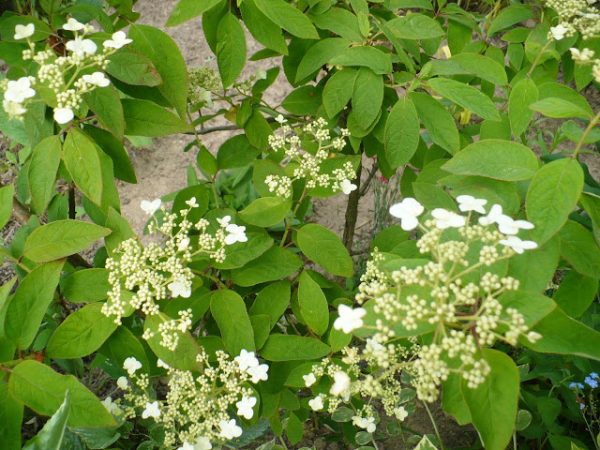
Hydrangea Bretschneideri
During the summer period, the plant will take root, adapt to new conditions and gain strength for wintering.
You can plant a flower in the winter. In order for the bush to take root, this is done a month before the onset of constant cold weather. Such a seedling needs special attention during preparation for the winter period.
Site selection and preparation
The planting of ornamental shrubs is planned, guided primarily by the criteria of park design. In this case, take into account:
- the size that the plant will reach;
- undesirability of transplants - their hydrangea is very painful;
- interaction with neighbors - this shrub belongs to the "curtain" type, creating the background of the composition.
These can be places along fences or walls of the house, in areas protected from the wind.
The bush grows well both in open, illuminated areas and in partial shade. Bretschnederi loves a "wandering" shadow: direct sun in the morning and evening hours, but shading at noon.
The roots of the hydrangea are superficial, the leaves are large, quickly evaporating water, therefore, in the hot weather, it loses a lot of moisture, which has a bad effect on decorativeness.
With full shade or less than 6 hours of sunshine a day, the branches are pulled out and flowering is suppressed until it disappears completely.
It is not recommended to plant hydrangea in close proximity to fruit trees and large-sized trees with a developed root system: poplar, birch. In the fight against them for water and food, she will definitely lose.
Bretschneider is the most drought-resistant of all, but it is better to choose a place for it on soils that hold water well, but without excessive stagnation of moisture, water and air permeable.
Hydrangeas have evolved to adapt to acidic soils (pH 5.5 - 6.5).Soils should be slightly acidic or neutral. Lime and alkaline soil is completely unsuitable for them. There they will hurt, weaken and stop blooming.
Before planting, the site is reclaimed. You can bring the acidity of the substrate back to normal with peat. At the same time, it will improve the air and moisture permeability of the soil. The site is carefully dug up, removing weeds, and organic matter is introduced: rotted manure, compost, humus.
Preparation of planting material
For planting, use purchased planting material or seedlings grown independently.
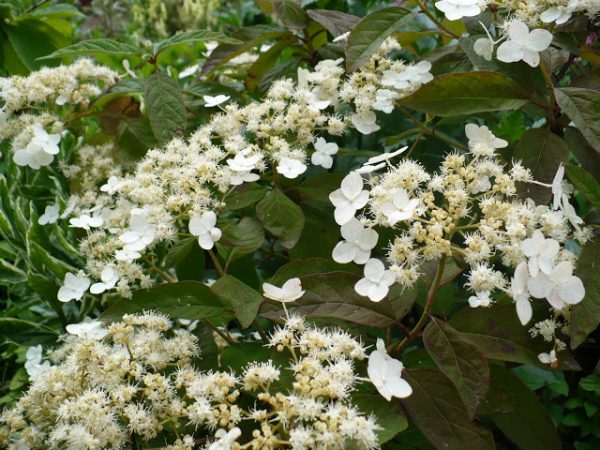
Hydrangea bretschneider photo
When buying, preferable plants with a closed root system (CCS), in containers. The species of hydrangeas, to which Bretschneider belongs, are usually not sold with “bare roots”.
Container planting promotes the development of a compact, branched root system. Therefore, when landing in open ground, it is almost impossible to damage it. Container seedlings do not have a limited planting time: they are able to take root during the entire growing season.
The optimal age of hydrangea seedlings is 3-4 years, and the optimal number of shoots is 2-3 pieces.
When choosing, pay attention to:
- the condition of the shoots - no spots, damage;
- turgor and color of leaves - elastic, firmly sitting on the petiole, juicy green;
- absence of parasites (cobwebs, egg-laying, caterpillars, etc.).
Then you need to gently pull on the stems of the seedling - if the plant is easily removed from the container, then it was only recently planted there and most likely with deformation of the roots. Such a bush can present many unpleasant surprises for the owner. On the contrary, if the seedling sits firmly in the container, and small roots come out of the holes of the container - the hydrangea was grown there, there is no doubt about its health.
Good seedlings come from Western European nurseries. They undergo strict phytosanitary customs control, are free from pathogens and are acclimatized to the conditions of Russia. You should be very careful when ordering seedlings over the Internet, especially from the countries of Southeast Asia.
The substrate of the container is peat, it does not retain liquid well. Immediately after the purchase, the earthen lump of plants is immersed in water and kept there until air bubbles cease to emerge.
Tplanting technology
The root system is located in the surface layer of the soil. Therefore, it is enough to dig a landing hole 30 cm deep. The diameter of the hole can be about 50 cm. But it depends on the structure of the soil. It is advisable to cultivate heavy loams with organic matter over a larger area.
In order to prevent stagnation of water (which is fraught with fungal diseases), it is necessary to do drainage. To do this, a layer of expanded clay, broken brick, pebbles is poured at the bottom of the planting pit.
To provide the required acidity of the substrate, it must be based on peat. On clayey soils, any organic matter (manure, humus) will always be useful to improve the structure of the soil.
Mineral fertilizers are added to the soil mixture:
- 100 g superphosphate;
- 20 g of potassium sulfate;
- 20 g of ammonium sulfate.
Then the following operations are performed:
- the hole is spilled with water;
- at the bottom of the pit, a small elevation is made, where the seedling is placed by transshipment;
- the soil is covered in small portions with its simultaneous compaction. Internal voids are unacceptable.
It is important that the root collar of the bush is at ground level; its further subsidence should not be allowed.
Mulching the soil helps to retain moisture, protects the roots from overheating, and inhibits weed growth. Pine bark, coniferous litter or spruce branches are used as mulch. With their help, a layer 7-10 cm thick is created along the projection of the crown or going beyond it by 15-20 cm. As it decomposes, this substrate will become part of the soil and acidify it.
How to care
Hortense Bretschneider is accustomed to the harsh mountain conditions, does not require constant attention and needs minimal maintenance.
Watering
Hydrangea - "vessel with water", this is how the word "Hydrangea" is translated from Greek - it characterizes a large and constant need for moisture.
The frequency and volume of watering is primarily determined by weather conditions and the age of the bush. Hydrangeas love water, but excessive moisture, especially at low temperatures, can provoke fungal diseases. Watering must be carried out when the topsoil dries up by 1-2 cm. After that, the trunk circle is necessarily weeded and loosened.
The first 1-2 years, young bushes are watered more often, adults - only with a prolonged absence of precipitation.
The plant tolerates a short-term drought, but if this period has dragged on and the leaves have already begun to fall off, it is "cast" gradually. It is more efficient to do this using drip irrigation. So the suction roots will revive faster and provide the bush with the necessary moisture.
Adult hydrangeas in the climate of Central Russia can do without artificial moisture. So, in the Pharmaceutical Garden of Moscow, they are kept without watering and at the same time do not lose their decorative properties.
Top dressing
They begin to feed the hydrangea for 3 years. Before that, she has enough nutrients laid in the planting pit.
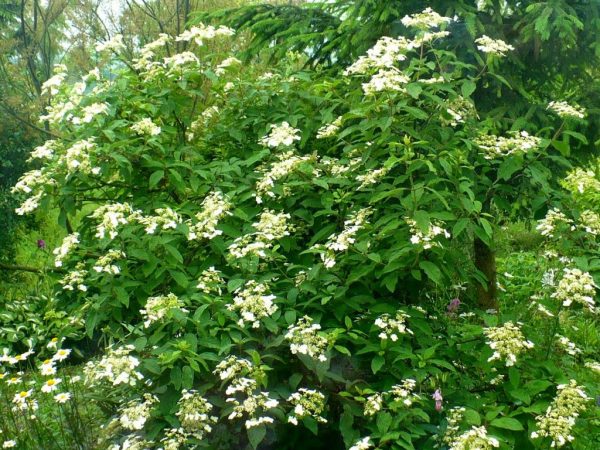
Hydrangea bretschneider description
It is necessary to maintain a balance between organic and mineral fertilizers.
Organic matter primarily improves the structure of the soil. Any plant needs three basic elements for its growth and development: nitrogen, phosphorus and potassium (NPK). And organic additives to the soil are not able to sufficiently meet this need. The problem is easily solved by using a mineral complex of full composition NPK.
A single dose of this tuk is 20 g (matchbox) per 1 m².
Three dressings are enough per season:
- at the beginning of the growing season;
- in the middle of summer, with budding;
- in September. to prepare for winter. Nitrogen should be excluded from the mineral composition, which provokes the growth of green mass, which negatively affects the winter hardiness of the culture.
In addition to the essential elements NPK, Hydrangea needs magnesium and iron. They are found in special fertilizers for azaleas and rhododendrons.
Pruning
Bretschneider forms flower buds on the shoots of the current year, she is not afraid of winter frosts. But due to early awakening, the stems fall under recurrent frosts. The bush is recovering, but there will be no flowering on such branches this year.
It is optimal to prune this hydrangea several times:
- in the fall - remove young, non-lignified shoots, which still will not survive the winter;
- in spring, after wintering, before the start of sap flow, cut off broken and damaged branches;
- after flowering, shorten the non-flowering shoot to a well-developed node with buds.
The formation of a half-stem shape, forming a beautiful vault, begins from the second year of planting.
For this:
- leave one or two of the most powerful shoots. The rest are cut "on the ring";
- in the third year, the shoot is cut at a height of 0.5 - 0.7 m, depending on the intended shape and height of the bush. During the growing season, 2-3 stems are formed;
- for the fourth and subsequent years, each branch is cut into 2-3 buds.
The operation is repeated until the desired splendor and shape of the bush is achieved.
Preparing for winter
Bretschneider's hydrangea is a frost-resistant variety; it does not need special measures to protect it from the cold. It is enough just to cut off the dried inflorescences so that the snow does not break the branches. Shelters are needed only for seedlings planted in deep autumn. Their root system is covered with a layer of mulch 10-15 cm thick from peat, sawdust, coniferous litter.
Reproduction
A groundcover hydrangea can be propagated by seed - thanks to its many fertile flowers, it produces a sufficient number of them.Ripe seed pods are harvested at the end of the season or purchased from specialized stores. In the spring they are sown in separate cups. Seedlings appear in a month. The annual growth of such seedlings is 15-30 cm. Reproduction by seeds is a long and laborious process.
In GBS RAS since 1938, 5 samples (8 copies) of Hydrangea bretschneideri were grown from seeds obtained from foreign and domestic gardens. At 42, the height of the bushes is 4.2 m, the diameter of the crown is 330 cm.
The main breeding method is vegetative. At the same time, the plants retain all the characteristics of the mother.
For Bretschneider, unlike other species, only cuttings are available. The bushes of this hydrangea do not give root growth and are large in size, therefore, it is possible to divide it only during transplantation.
Propagation by cuttings
This is the simplest and most common way. To do this, take annual shoots approximately 8-10 cm long. The best time to cut branches for successful rooting of cuttings is the flowering period (mid-July). You can cut the hydrangea before flowering, in June, but in this case, by cutting the cuttings, they retain a small part of last year's shoot, the so-called heel.
Each stalk must have at least two internodes. The lower leaves are removed, the leaf plates of the upper ones are cut in half to reduce moisture evaporation. The lower cut of the cutting is made oblique, the upper cut is straight. Cuttings are treated with a growth stimulant and planted in separate containers with a high-quality substrate of peat and sand (1: 1). To increase the moisture content, chopped sphagnum moss can be added to the substrate.
After planting in containers, the seedlings are covered with a cut plastic bottle or jar on top, thus creating a micro-greenhouse. Further, it is necessary to ventilate the sprout daily, while maintaining the necessary humidity. Rooting takes about three weeks.
According to statistics published on the website of the GBS RAS, the rooting rate of Bretschneider cuttings without stimulant treatment reaches 70%, with treatment - 90%.
The plant is planted in a permanent place only the next year. For its wintering, it is optimal to use a cellar or basement. Any room with approximately freezing temperatures will do.
Diseases and pests: treatment and prevention
The main threat to this ornamental shrub is represented by fungal diseases. White bloom on the leaves will indicate powdery mildew. Brown spots indicate the presence of gray rot.

Hydrangea bretschneider planting and care
Their causes are high humidity due to excessive watering and thickening of the plantings.
For the prevention of diseases, it is necessary to carry out sanitary pruning more often, removing damaged branches and thinning bushes.
The main means of fighting fungi are fungicides. And here in the first place is the copper-containing Bordeaux liquid. Modern biofungicides such as phytosporin are also effective.
Another danger is posed by insect pests. They not only damage the plant themselves, but also carry viral diseases.
Currently developed insecticides make it easy to fight this scourge. The main thing here is to notice the problem in time.
Application in landscape design
Hydrangea Bretschneider, being a large-scaler, is capable of creating compositions of considerable size. It will decorate a city park, a private estate, natural or man-made stone slides.
Suitable for single and group plantings, for creating hedges, for padding tall trees.
Looks great in combination with decorative viburnum, hawthorn or Köne mountain ash.
In the Finnish arboretum of Mustila, Bretschneider hydrangeas grow on the terrace, forming a beautiful vault above the path.
The culture looks great near water bodies and against the background of walls made of stone or red brick. It is planted near gazebos, benches and other small architectural forms.
Indispensable in Japanese and Chinese style gardens.
Cut flowers will stay in the vase for a long time if you add a few drops of detergent and sugar to the water. Hang the inflorescences with their heads down and dry. You will receive a wonderful winter bouquet to celebrate World Hydrangea Day on January 5th.
Testimonials
Gardeners note the frost resistance and drought resistance of Bretschneider hydrangea with extraordinary decorative qualities.
Owners of large personal plots consider simplicity of reproduction to be an advantage - by seeds and cuttings. Florists love the opportunity to create beautiful compositions from dry buds.
Residents of areas with recurrent spring frosts are concerned about freezing of the flower buds of the plant in April-May and the lack of flowering for this reason.
Landscape designers note sophistication and simplicity, an organic combination with popular garden and park plants.
The beautiful and sophisticated Hydrangea "Bretschneideri" is still a rare guest in our gardens and parks. However, it is already obvious that it will conquer Russia just as it conquered the gardens of the East, and will soon replace lilacs and mock-orange in the parks .. And so be it!


